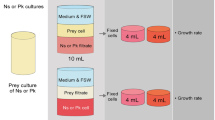Abstract
The calanoid copepods, Acartia clausi Giesbrecht and Acartia tonsa Dana, are maintained at high densities in continuous culture at 15°C. Synthetic sea-water medium is recirculated through filters and a foam tower which limits accumulation of dissolved wastes and various metabolites. The ciliate Euplotes vannus Müller is associated in culture with the copepods, and effectively controls bacterial population and accumulation of algal debris. The copepods graze upon the ciliates as well as upon the phytoflagellates Isochrysis galbana Parke and Rhodomonas baltica Korsten.
Similar content being viewed by others
Literature cited
Baylor, E. R. and W. H. Sutoliffe, Jr.: Dissolved organic matter in seawater as a source of particulate food. Limnol. Oceanogr. 8, 369–371 (1963).
—— and D. S. Hirschfeld: Adsorption of phosphates onto bubbles. Deep Sea Res. 9, 120–124 (1962).
Brunner, C. A. and D. G. Stephan: Foam fractionation. Ind. Engng. Chem. 57, 40–48 (1965).
Corkett, C. J.: Technique for rearing marine calanoid copepods in laboratory conditions. Nature, Lond., 216, 58–59 (1967).
Greve, W.: The “planktonkreisel”, a new device for culturing zooplankton. Mar. Biol. 1, 201–203 (1968).
Heinle, D. R.: Production of a calanoid copepod, Acartia tonsa, in the Patuxent River estuary. Chesapeake Sci. 7, 59–74 (1966).
—: Culture of calanoid copepods in synthetic seawater. J. Fish. Res. Bd Can. 26, 150–153 (1969).
Lewin, J.: Silicon metabolism in diatoms. 5. Germanium dioxide, a specific inhibitor of diatom growth. Phycologia 6, 1–12 (1966).
Lewis, A. G.: An enrichment solution for culturing the early development stages of the planktonic marine copepod Euchaeta japonica Marukawa. Limnol. Oceanogr. 12, 147–148 (1967).
Lowry, O. H., N. J. Rosebrough, A. L. Farr and R. J. Randall: Protein measurement with the Folin Phenol Reagent. J. biol. Chem. 193, 265–275 (1951).
Mullin, M. M. and E. R. Brooks: Laboratory culture, growth rate, and feeding behavior of a planktonic marine copepod. Limnol. Oceanogr. 12, 657–666 (1967).
Riley, G. A., P. J. Wangersky and D. V. Hemert: Organic aggregates in tropical and subtropical surface waters of the North Atlantic ocean. Limnol. Oceanogr. 9, 546–550 (1964).
Sieburth, J. Mc.: Studies on algal substances in the sea. 3. The production of extracellular organic matter by littoral marine algae. J. exp. mar. Biol. Ecol. (in press).
Wallace, G. T., Jr. and D. F. Wilson: Foam separation as a tool in chemical oceanography. N.R.L. Rep. No. 6958 (1969).
Zillioux, E. J.: Ingestion and assimilation in Acartia. 31st A. Mtg Am. Soc. Limnol. Oceanogr. (1968).
— and D. F. Wilson: Culture of a planktonic calanoid copepod through multiple generations. Science, N.Y. 151, 996–998 (1966).
Author information
Authors and Affiliations
Additional information
Communicated by G. L. Voss, Miami
Contribution No. 119 from the Institute of Marine and Atmospheric Sciences, University of Miami.
Rights and permissions
About this article
Cite this article
Zillioux, E.J. A continuous recirculating culture system for planktonic copepods. Mar. Biol. 4, 215–218 (1969). https://doi.org/10.1007/BF00393895
Accepted:
Issue Date:
DOI: https://doi.org/10.1007/BF00393895




